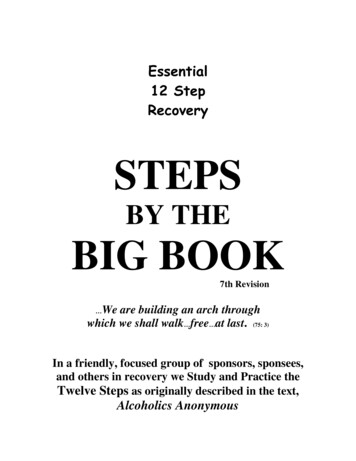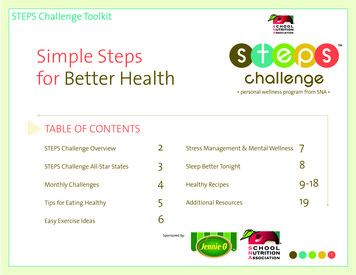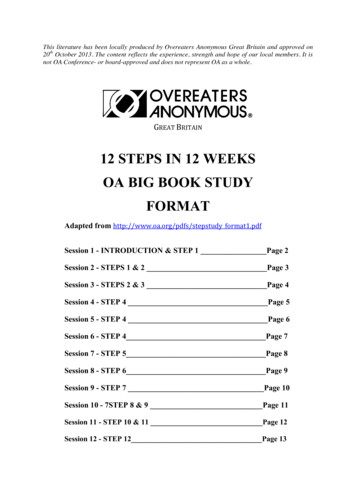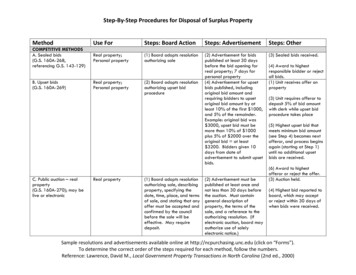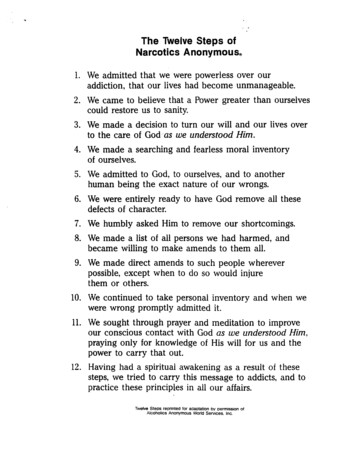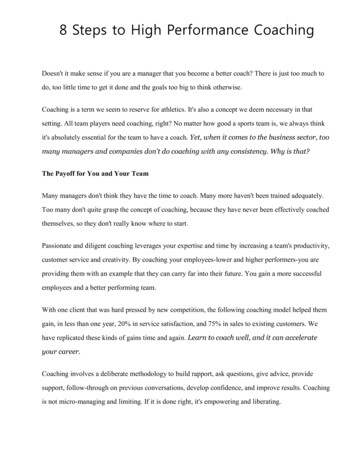
Transcription
8 Steps to High Performance CoachingDoesn't it make sense if you are a manager that you become a better coach? There is just too much todo, too little time to get it done and the goals too big to think otherwise.Coaching is a term we seem to reserve for athletics. It's also a concept we deem necessary in thatsetting. All team players need coaching, right? No matter how good a sports team is, we always thinkit's absolutely essential for the team to have a coach. Yet, when it comes to the business sector, toomany managers and companies don't do coaching with any consistency. Why is that?The Payoff for You and Your TeamMany managers don't think they have the time to coach. Many more haven't been trained adequately.Too many don't quite grasp the concept of coaching, because they have never been effectively coachedthemselves, so they don't really know where to start.Passionate and diligent coaching leverages your expertise and time by increasing a team's productivity,customer service and creativity. By coaching your employees-lower and higher performers-you areproviding them with an example that they can carry far into their future. You gain a more successfulemployees and a better performing team.With one client that was hard pressed by new competition, the following coaching model helped themgain, in less than one year, 20% in service satisfaction, and 75% in sales to existing customers. Wehave replicated these kinds of gains time and again. Learn to coach well, and it can accelerateyour career.Coaching involves a deliberate methodology to build rapport, ask questions, give advice, providesupport, follow-through on previous conversations, develop confidence, and improve results. Coachingis not micro-managing and limiting. If it is done right, it's empowering and liberating.
The High Performance Coaching ModelOne-on-one formal coaching sessions requires an investment in time (Usually 30-60 minutes a session).I recommend at least monthly in most cases. The sessions are valuable for these reasons: Promotes effective communication and trust. Creates an employee-manager relationship. Creates an atmosphere of continuous improvement. Helps businesses and employees reach and exceed their goals. Aids daily performance management.Here are eight formal coaching steps that the best managers do, and the worst managers don't do ordon't do very well. In order to get a gauge as to where you might stand on the coaching spectrum,evaluate how you think you do in each of these areas.Step 1 - Pre-meeting preparation (action plans, numbers, goals, etc.)Step 2 - Greeting (be positive, do some small talk, ensure privacy.)Step 3 - The bottom-line is be a good listener. Your goal is to help an employee orthe person you are coaching to solve his or her own problem through creative,innovative or common sense thinking. Use the ASK Model of questioning. Engage theemployee in a dialogue about their goals, action steps, problems, and potential solutions. As you talk,praise progress, recognize good performance, and identify areas to improve. Ask with these types ofquestions to begin: How is it going since we met last time? What progress did you make on your goals and action plans? What went well? What didn't go well? What areas do you need help?
Step 4 - Ask the employee to tell you how and why they made their decisions. Ask these kinds ofquestions: What was your thinking process? What did you do next? What more could you have done? What can you differently or better next time? How can I help you?Step 5 - Seek solutions and build a new plan on how to improve the results. Ask questions like these: What other ideas do you have for improvement next time? What do you think of this idea. ? Did you try. ? Are you open to some suggestions? Have you thought about trying. This is what I recommend.(Yes, in many cases, a manager or coach does need to makesuggestions or recommendations. Not all employees will come up with good plans or ideas.Now, don't start here, you precede your thoughts by doing a good job of communicating withthoughtful questions and active listening.)Step 6 - Keep plans and commitments. Make sure to review all key action steps from the last meeting.Set new goals and action steps if necessary.Step 7 - Summarize your discussion and an updated action plan in writing. (Keep it more informal, on1-2 pages if you can). This will help with performance reviews later.)Step 8 - Schedule another meeting and show your appreciation for the employee's efforts. Ensure thatyou follow-through.Notice you ask a lot of questions. Again, you need to be a good listener; and you strategically givefeedback and guidance if needed. Coaching is not a place for yelling and telling. Managers who do that
are archaic. Also, just note that all of your other work related interactions with employeestexts, meetings, casual encounters, phone conversations- support or detract from yourcoaching efforts.An Antidote for Employee DisengagementOne on one coaching is specifically about effective communication and performance. You talk aboutgoals, expectations, problems, and solutions to those problems. You give employees positive feedbackabout their efforts while identifying performance issues clearly and directly. You develop employeeskills and attitude about getting the job done well and achieving the best results. You train employees tothink proactively when faced with challenges, and obstacles. All of these actions help create robustemployee engagement.Over the course of time, the coaching process teaches employees problem-solving skills they canexecute more effectively on their own. They become more innovative and learn to take initiative to gothe extra mile. Excellent coaching actually saves you time. Managers really can't afford not tocoach but it's becoming a lost art.So, if you're hesitating about whether or not high performance coaching is for you, ask yourself thisnext question. Which team would you feel more confident cheering for during World Cup Soccermatch, one that had no coach, or one that had a coach with a championship reputation?By: Rick ConlowThis article was originally posted at: g/Visit Bishop House’s Leadwell Knowledge Base for more resources on the topicsthat matter most to leaders
Jan 08, 2018 · Coaching is a term we seem to reserve for athletics. It's also a concept we deem necessary in that setting. All team players need coaching, right? No matter how good a sports team is, we always think it's absolutely essential for the team to have a coach. Yet, w


